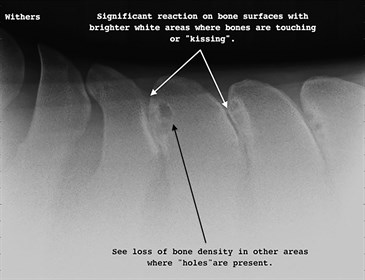|
This article first appeared in a previous issue of Equestrian Life magazine. To read our current free issue, click here.

Kissing spine.
Q: A friend believes my horse has something called kissing spines. What is this condition and can anything be done about it? - JDR, Cessnock, NSW
A: Kissing spines is the common name for overriding or impinging of two or more vertebrae (the dorsal spinous processes) in the back. Dorsal spinous processes are the top parts of the vertebra that extend upwards from the body of the vertebrae; they normally do not touch each other and are separated by an interspinous ligament. Kissing spines is a common cause of back pain, however, some horses can have spinous processes that touch and never show any pain related to them.
Kissing spine occurs in the section of the spine from behind the withers to forward of the pelvis, generally from the 11th thoracic vertebra through to the second lumbar vertebra. Most commonly, the main vertebrae involved are around the 15th vertebra (14th through to the 17th). The 15th vertebra usually corresponds to the point where the rider sits.

The 15th vertebra usually corresponds to the point where the rider sits.
Kissing spines are though to be due to a conformational predisposition or susceptibility (weakness the horse is born with) which is then made worse by factors such as inappropriate riding techniques, saddle fit and exercise regimens.
To diagnose kissing spines, the vet generally will need to listen to the history of the horse (what the horse is doing that worries you, how long it has been worrying you and any events or accidents that may have happened since you have had the horse). The vet should also feel along the back, looking for signs of pain, particularly in the area where the rider sits. Radiographs are then taken of the tops of the spinous processes to see if there is crowding or touching of the spinous processes. It is important for the vet to listen to the history and to palpate the back, as not all horses with radiographic evidence of kissing spines will have a problem. Other less common ways of diagnosing kissing spines include thermography, ultrasonography and scintigraphy.
Treatment of kissing spines can involve conservative and surgical options. Conservative options include the use of shockwave therapy, anti-inflammatory injections into the back, bisphosphonate drugs (tildren), physiotherapy and chiropractic interventions. Surgical options usually involved either removing the tops of the spinous processes or cutting away the ligaments between the spinous processes, to allow more movement and reduced pain. It would also be beneficial to have the saddle fitted by a professional, and the training regimen modified to encourage strengthening of the back muscles and thus stability of the spine.

Kissing spine.
© Maxine Brain
This article has appeared previously with Equestrian Life. To see what's in our latest issue, click here.
READ THE LATEST NEWS ARTICLES HERE
|

